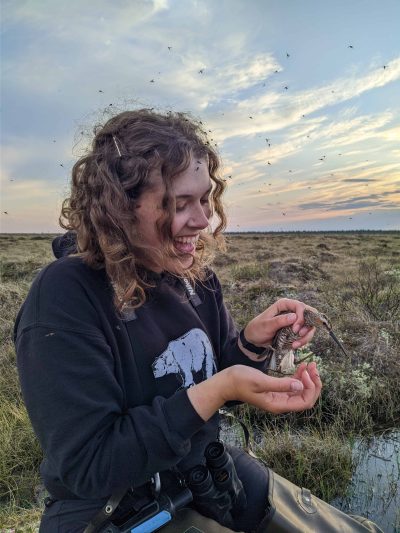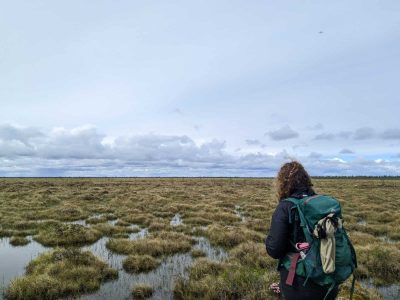Researcher Feature
Olivia Maillet
MSc candidate in Environmental and Life Sciences in Dr. Erica Nol’s lab at Trent University whose focus species are the Stilt Sandpiper and the Short-billed Dowitcher

Background
I completed my BSc in Environmental and Resource Science at Trent University as well, during which time I conducted research using community science (eBird) data to study Killdeer habitat selection.
Current Research
The aim of my MSc project is to study the incubation biology and migration ecology of two poorly known shorebirds breeding at the unique intersection of the boreal forest and tundra that characterizes the Churchill region.
I am interested in what affects nest success in Stilt Sandpipers and Short-billed Dowitchers breeding in wet sedge meadows.
- Does the encroaching treeline in previously open meadows influence their nest site selection and nest success?
- How do these factors differ between boreal and open tundra-nesting species?
I am also interested in the migration pathways and timing of both species.
During the last two summers, I deployed tiny radio-transmitters on shorebirds nesting in Churchill to track their southbound migration with the Motus network.
- Do the Short-billed Dowitchers breeding in Churchill follow a similar migration pathway to other subpopulations and subspecies?
- What affects the timing and speed of migration?
This project is a collaboration with the Smithsonian Institute and Environment and Climate Change Canada.

the summer spectacle
My favourite part about conducting my research is watching the seasons change.
This year, we arrived in Churchill a week earlier than usual, so we were able to see seals out on the ice, watch the snow melt, and welcome many different bird species arriving from their South American wintering grounds.
The transition from June to July brings chaos. Due to the short warm season, most of the nests in Churchill hatch within a week, and suddenly the landscape is filled with baby birds and anxious parents.
Just as soon as they arrive, it is bittersweet to watch the shorebirds raise their young and depart once again for their wintering grounds.
The blooming fireweed in mid-July is the most beautiful consolation prize once bird activity slows down.

A typical day
An average day for me at the CNSC starts by waking up around 7:30am for breakfast.
We then head out down Twin Lakes Road to the fen where we conduct our work for the day, decked out in hip waders and bug jackets to face the elements.
Depending on the weather, we return around 5pm for a delicious dinner, a hot shower, and enjoy socializing with other research teams in the evening.

AT THE CNSC
This past summer, I spent my second and final field season of my Master’s degree in Churchill working out of the CNSC.
Over the last couple of years, the CNSC has provided an excellent home base for our field team, funded our research through the Northern Research Fund, and assisted logistically in any way we needed. The CNSC fosters an amazing environment for networking with other researchers, both domestic and international.
I hope I get the opportunity to visit Churchill again in the future and reconnect with the lovely folks at the CNSC.
Meet other Researchers
Research: A Day in the Life
After a stint as a Research Technician with the CNSC, Joni Reimer returned as the Research Coordinator in December of 2022
Read MoreResearcher Feature: C-Jae Breiter
Research Conservation Specialist at Assiniboine Park Zoo with a focus on northern ecosystems
Read MoreResearcher Feature: Chloé Warret Rodrigues
PhD student at the University of Manitoba whose focus species is the fox
Read MoreThe Churchill Northern Studies Centre hosts an average of 1,100 research user days in a typical year. Researchers who study at the Centre receive accommodations, equipment, laboratory space, vehicle rentals, and logistical support, all at an extremely affordable rate.
Please consider supporting the CNSC and allowing us to continue offering this critical service.



